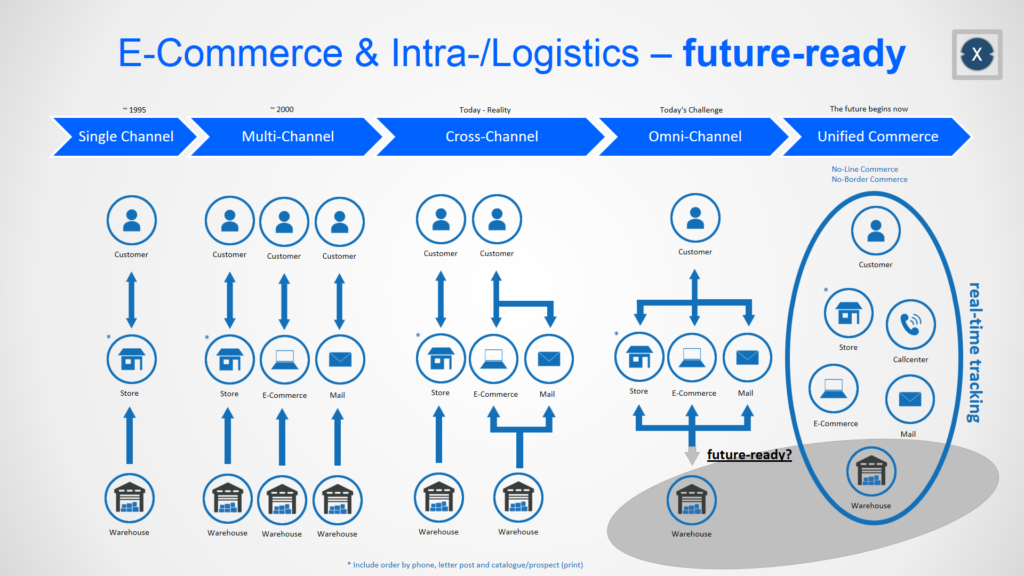Ready for cross-channel sales thanks to powerful IT
Although the terms no-line commerce or unified commerce have been circulating in the specialist media for some time, their meaning is still not clear to many managers and those responsible. The timely implementation of this, for now, the last evolutionary stage of e-commerce sets the course for a successful future in retail – online and offline.
The endless shelf with no-line commerce, unified commerce, no-border commerce
In addition to smoothly functioning intralogistics with optimized storage conditions, the efficient interlinking of IT processes is an absolute prerequisite for no-line commerce, which puts the customer experience at the absolute center of all efforts by no longer making any difference between the individual sales channels, between online and offline or intermediate models. This is exactly what distinguishes No-Line from older approaches such as multi- or omnichannel, because with the No-Line solution the customer should not even notice which channel they are using to contact the retailer. To do this, identical information must be made available on all sales channels.
With no-line commerce, instead of silos in logistics, IT or marketing/sales, there is only one limitless “one”. In order to provide customers with the “ Endless Aisle ” experience, seamless integration of IT and logistics structures is required. Efficient digital processes are crucial. Because they are the ones who ensure that all products are always available to the customer across all channels and that the retailer keeps an overview. In order to capitalize on this competitive factor, retailers must ensure that all relevant information about the current inventory and the location of the individual items is available at all times - whether in the warehouse, the branch, on the way to the next touchpoint or to the customer.
To ensure this, 53% of those responsible want to establish a uniform commerce platform for their business in the next few years, according to surveys. As many as 86% of respondents plan to operate a unified e-commerce platform within the next 10 years.
Requirement for the implementation of no-line commerce
No-line commerce requires a fully digitally networked system world, because how else is it possible, for example, to return an item purchased online in a store offline and map this process one-to-one? In principle, no-line commerce is a solution for all retailers with different sales channels. However, due to the complexity of the task, it is more feasible for larger companies, as implementing an all-in solution for e-commerce, the other channels and precise order and inventory management, including tracking of technical processes to the second, requires a lot of technical know-how. Aids such as QR codes or RFID chips can be used for precise tracking and inventory of inventory. However, in order for tracking to work, it must be ensured that the existing software is designed to meet such requirements. It will become even more difficult if retailers rely on self-learning systems such as artificial intelligence in the future: much larger data streams will have to be managed in order to ensure an ideal overview at all times.
Anyone who does not have the necessary knowledge available in-house can access external consultants . With their expertise, they help analyze internal IT and logistics processes and make the business fit for digital change.
Absolute transparency in inventory management
The complex IT and workflow processes in no-line commerce require highly efficient processes. The greatest possible flexibility and control are required so that customers always receive the right product via the respective channels and do not lose track of the logistics behind it. Where previously you had to ask in the store whether a certain item was available, today there must be absolute transparency online about the stock in the warehouse or branch.
Compared to previous times, the difficulty lies in creating transparency across channels, not just individual channels. For this, retailers need a central platform that reliably informs them about inventory levels in all sales channels at all times - SPOT data management ( SPOT - Single Point of Truth / SSOT - Single Source of Truth ). At the same time, it must be possible to create forecasts in order to increase stocks accordingly in times of high demand, for example before the Christmas shopping season, so that availability is guaranteed at all times. This requires comprehensive networking of all warehouse structures in central and intermediate warehouses as well as in the individual shops or at other touchpoints.
All in one platform
Xpert.Digital partners offer you a modern alternative to introducing a new ERP system by using a cloud-based platform solution for existing systems. They bring the trading processes into the cloud and provide availability and speed in all channels and processes.
A first step towards this is the merger of existing merchandise management and order management systems. If this data is made visible online, unsuccessful visits by customers to stores will become a thing of the past. Instead, goods can be proactively moved to specific locations when the software detects increased demand for those items in that location. The consequence is a better purchasing experience for the customer as well as increased inventory turnover and higher sales. smart devices can be used, which act as a link between customers and retailers in no-line commerce and thus enable an optimal purchasing experience at any time and anywhere.
To ensure this, success depends on smoothly integrated logistics and IT. The model can only be successful if the logistics processes run efficiently and high-performance interfaces are created with which the data can be transported both internally and to the customer.


